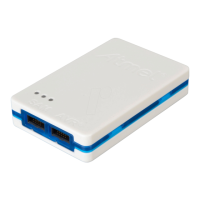Table 4-5. AVR JTAG Pin Description
Name Pin Description
TCK 1 Test Clock (clock signal from the Atmel-ICE into the target device).
TMS 5 Test Mode Select (control signal from the Atmel-ICE into the target device).
TDI 9 Test Data In (data transmitted from the Atmel-ICE into the target device).
TDO 3 Test Data Out (data transmitted from the target device into the Atmel-ICE).
nTRST 8 Test Reset (optional, only on some AVR devices). Used to reset the JTAG TAP
controller.
nSRST 6 Reset (optional). Used to reset the target device. Connecting this pin is
recommended since it allows the Atmel-ICE to hold the target device in a reset
state, which can be essential to debugging in certain scenarios.
VTG 4 Target voltage reference. The Atmel-ICE samples the target voltage on this pin in
order to power the level converters correctly. The Atmel-ICE draws less than 3mA
from this pin in debugWIRE mode and less than 1mA in other modes.
GND 2, 10 Ground. Both must be connected to ensure that the Atmel-ICE and the target
device share the same ground reference.
Tip: Remember to include a decoupling capacitor between pin 4 and GND.
4.3.2.2. JTAG Daisy Chaining
The JTAG interface allows for several devices to be connected to a single interface in a daisy chain
configuration. The target devices must all be powered by the same supply voltage, share a common
ground node, and must be connected as shown in the figure below.
Figure 4-7. JTAG Daisy Chain
TMS
TDI
TDO
TCK
target
device
1
target
device
2
target
device
3
programmer /
debugger
When connecting devices in a daisy chain, the following points must be considered:
• All devices must share a common ground, connected to GND on the Atmel-ICE probe
• All devices must be operating on the same target voltage. VTG on the Atmel-ICE must be
connected to this voltage.
Atmel Atmel-ICE [USER GUIDE]
Atmel-42330C-Atmel-ICE_User Guide-10/2016
31

